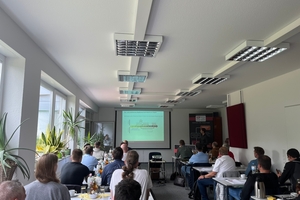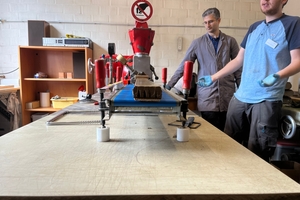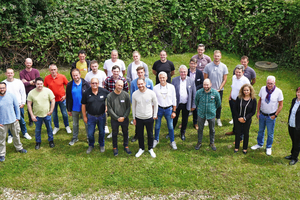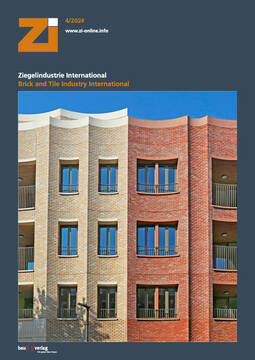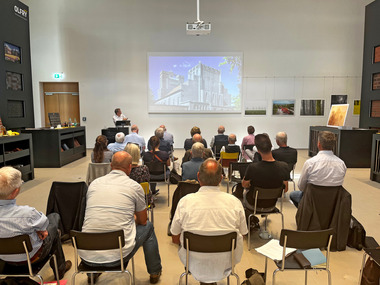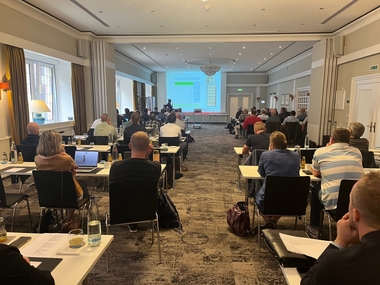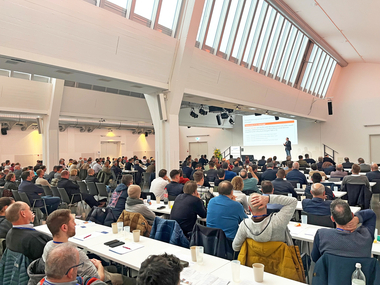Good and practical lessons for career changers in Essen, Germany
Thanks to the Institute for Brick and Tile Research (IZF), Essen is a specialist training centre for the brick and tile industry in Germany. In addition to the annual research seminar held in autumn, a seminar for career changers has been offered since 2023. After two very well-attended dates last year, the event took place again on 4 and 5 June 2024.
The seminar was fully booked with almost 30 participants. The participating editor was surprised by the broad appeal of the event format. In addition to newcomers to the brickworks from outside the industry, the seminar was also attended by some industry returnees who had been working in other fields for a while. Other participants came from companies in the supplier and mechanical engineering sector and from the structural and civil engineering and project development sectors. A private individual from Austria with an interest in bricks and brickworks was also present.
The topical journey, starting at the mine and ending with the finished product, was divided into four thematic blocks and one practical block.
Raw materials and extraction
The first block, presented by Sandra Petereit, focussed on brick raw materials and their extraction. The formation of clay from weathering and sedimentation, the chemical characterisation as aluminium silicates, the crystalline structure of clays and the various clay minerals were discussed. The mineralogical composition determines the properties of the clay. Important properties for further processing such as plasticity, grain size and distribution were discussed. The conclusion of the discussion is that clay and its intended use must be harmonised.
Clay extraction was discussed on the basis of the individual steps: Exploration and authorisation, test drilling, discussion of the raw materials that can and cannot be used for brickmaking. The preparation of raw materials was also discussed: Crushing, mixing, dosing, homogenising.
Shaping
The second thematic block initially dealt with the conditions for shaping clay bricks. The property of plasticity was characterised, as well as the process of clay disintegration leading to this. The method for measuring the residual compression height of a clay body according to Pfefferkorn was also presented.
The shaping process itself was described using the methods and machines presented for vertically perforated bricks and roof tiles. The seminar concluded with a discussion of various typical moulding defects (deformation, cracking, texture formation) and their causes. The speaker was also Mrs Petereit.
Drying
Eckhard Rimpel presented the third topic block. The discussion of the processes that determine the drying speed and the changes in the properties of the green body was dedicated to the theoretical principles of drying. In particular, the requirements for drying and the product properties that influence the drying process (raw material composition, moulding, format) were discussed. Convection drying and the influence of processes inside and outside the green body were described and discussed in detail. The phenomenon of drying shrinkage was analysed. It was also discussed how the product‘s susceptibility to drying cracks can be reduced by using fibres in the clay body.
Under the heading of drying process engineering, Rimpel presented the various types of ventilation and control. The Mollier diagram was discussed in detail, which can be used to describe drying processes as a function of the temperature of the moist air, the water content of the dry air and the relative humidity. Dry efflorescence was discussed in particular. Caused by CaSo4 dissolved in water and crystallised in the course of drying, a higher diffusion flow, achieved by raising the green body‘s temperature or a lower drying speed, could help to reduce this.
The process analysis of the drying process was discussed on the basis of dryer measurements. Rimpel explained which measuring devices and values can be used to analyse which processes inside and outside the green body during the drying process. In addition to flow measurement and flow profile, he also focussed on the basis for calculating energy balances and dryer energy consumption. Uneven drying due to wall influence, insulation problems in chamber dryers, heat requirements during initial drying and the optimisation of the effect of rotary fans were also addressed. The conclusion was apt: “Drying problems can be manifold. It is therefore advisable to devote the same ‚metrological attention‘ to the dryer as to the kiln.“
Practical block
The practical block at the end of the first day‘s teaching consisted of three stations where the seminar participants had the opportunity to: hold various clays in their hands, perceive their differences and try their hand at hand moulding; try out vacuum moulding on a model extrusion press; and practise measuring material parameters on a test specimen.
The first day of the career changer’s seminar ended with a cosy get-together, as is a tradition at IZF seminars.
Firing
The fourth block of topics was dedicated to firing, the general topic of the second day of the seminar. The speakers were Alexander Winkel, Sandra Petereit and Eckhard Rimpel.
Firstly, the influence of the raw material on the firing process was discussed. The endothermic and exothermic reactions that take place during the firing of bricks were presented. It was also explained how the different reaction heats of clay and non-clay minerals lead to an adjustment of the firing curve depending on the clay composition. The benefits of thermal analyses for creating firing curves were also discussed. The three common methods were presented: Simultaneous thermal analysis, dilatometry and expulsion curves (see ZI 6 /22, pages 42 and following).
This was followed by an explanation of the tunnel kiln as a firing unit. A general discussion of heat transfer (convection and radiation) and heat conduction (direct and indirect) was followed by an in-depth discussion of heat transfer in the tunnel kiln. It was explained how burners affect the kiln chamber and the material to be fired, how combustion calculations are carried out and the differences between classic and modern tunnel kilns. Among other things, the role of the charge structure for heat transfer, the orientation of the air injection and the burner spacing were discussed.
The combustion chamber atmosphere was presented as a combustion system. The theoretical principles of combustion were recalled, basic terms were presented and, using the example of the different types of natural gas, their effects on the combustion properties were discussed. The advice to adapt the combustion air flow to the actual demand of the gas used in order to save energy was practically helpful. The discussion of gas-generating raw material reactions and process-related emissions, fluorine, sulphur and chlorine compounds as well as smouldering gases and odour emissions, was given a lot of space.
This was followed by a discussion of the causes of damage caused by fire. Damage can be divided into cracks, flaking and swelling as well as discolouration. The causes for their formation were explained: stresses exceeding the strength of the green body, gas-forming reactions and the incomplete oxidation of organic components or reduction phenomena. Damage formation was reconstructed as a function of the temperature range and methods of prevention were presented in each case.
The topic of operational measurements was dealt with under the two aspects of measurement purpose and object. The measurements help with quality assurance, determining energy consumption and balance and understanding processes. The temperatures of gas and air, the pressures, the flows and volume flows as well as the gas compositions are measured. Sources of heat loss such as flue gas heat exchangers and tunnel kiln cars were addressed. The implementation and purpose of flue gas analyses to optimise burner settings to save energy was also discussed.
The last topic on the agenda was fired colours. After an introductory clarification of the reasons for the colouring of bricks, the main focus was on ways to achieve brick colour: via raw material composition, additives, firing process, combustible components, firing chamber atmosphere, engobes and glazes. The effects of these were explained in detail.
Conclusion
The seminar was worthwhile for the participating editor (with little prior knowledge). The material was systematically and didactically well prepared, and despite the sometimes brittle subject matter, the delivery was not without humour. The other participants were of similar opinions. The practical exercises and the focus on the practical applicability of the knowledge imparted were particularly praised.

